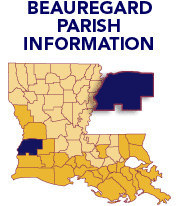Beauregard Parish - What HappenedOn Sept. 24, 2005, Hurricane Rita struck Beauregard Parish. While the storm surge did not reach Beauregard Parish, the eye path of the hurricane was just west of the Sabine River in Texas, putting the parish on the most destructive, northeast side of the storm. Numerous tornadoes scattered damage to the timber crop, homes and public buildings. Sustained winds up to 120 mph were experienced as far north as De Ridder, the parish seat and largest of the two cities in the parish. While approximately 30 to 40 percent of the residents evacuated, they quickly returned after the storm. For those who stayed, there were few places of refuge, particularly in the southern part of the parish. Numerous evacuees from Hurricane Katrina were already in the parish and more were being accommodated. Many residents stayed because the main evacuation routes of U.S.171, Louisiana State Route 27 and U.S.190 were clogged back to where all three routes intersect in Downtown De Ridder. After the storm local residents were further impacted by this congestion when they were denied access to nearby relief supplies in Calcasieu Parish and instead told to go to De Ridder at the other end of the parish. The lack of preparation and shelters, particularly in the rural areas, created significant hardship for local residents and evacuees. Many historic buildings and business tenants in downtown De Ridder were damaged due to lack of maintenance; homes built without building codes were easily damaged; and public facilities and infrastructure failed due to lack of redundant systems. The limited local infrastructure, staffing and fiscal capacity hampered emergency response and will present a challenge both for recovery and preparation for the next storm. |







